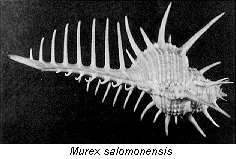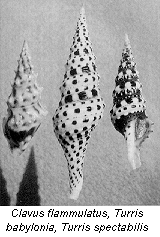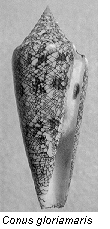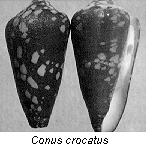Collecting in The Solomons, Or No Wonder Gene Came Home With a Grin on His Face!

In June, 1996, I went on a collecting trip to the Solomons. Our group included Wayne Harland, Homer Rhode, Karlynn Morgan and myself. We arrived at Honiara, Guadalcanal, the capital of the Solomons, on June 9th. We boarded the Wyuna, with Brian and Mary Claire Bailey, and we began collecting that same day. Snorkeling near the mouth of the Lungga River in very poor visibility, on dark sand, we found Conus monachus at 10' and deeper under rocks, and in the open, C. figulinus, Thais buccinea on a silty log, and Oliva vidua. That night, using SCUBA at 50-65' depth, we collected Terebra commaculata at the end of a sand trail, and Murex tenuirostrum, Cypraea onyx melanesiae and Oliva rufula, all in the open. A second dive that night off the Honiara Airport, starting at about 100' and working up to 15' on a silty slope, yielded Conus hopwoodi, C. betulinus, Strombus marginatus septimus, Cymatium gutturnium, Trigonostoma obliquata, Glycymeris reevei, Phalium areola, P. bisulcatum, pretty Natica undulata, N. alapapilionis and N. vitellus. Oddly enough, whenever we found Conus betulinus, it had another species on its back, Trigonostoma obliquata, for instance. The Phalium areola was crabbed. We also found Murex salomonensis and M. tenuirostrum, but I won't mention them again, because we found them at many sites at night.

The next day was spent traveling; we anchored for the night and dove at Vulalua Island. The depth was 35' on a silty bottom. We collected Harpa amouretta out on the sand, crawling with its wide, fleshy foot, Strombus labiosus, Bursa tuberosissima and B. rana. Conus pohlianus (which the latest cone book calls C. consors form pohlianus) and an unusually marked C. leopardus with markings much larger and fewer than normal were both at the base of a small reef on sand at about 30'. The following morning, some of us walked on exposed flat reef along the shoreline. Thais tuberosa was abundant and I found my first Turbo sparverius and a large, 81mm Asaphis violascens.
We left Guadalcanal and crossed over to the Florida Islands group. Killing time 'til dark, we snorkeled at Nuggu Island, where we found Conus episcopatus under a rock, and several common species such as Cypraea arabicula. Our night dive, at Mandoleana Island, yielded Fusinus colus at 90' on sand, Chicoreus paini and C. axicornis both crabbed on the sand and rubble slope, and a Harpa harpa at 55' on sand. A Cypraea cribraria was at 10' on a coral head, and Conus ammiralis was at 90' while C. planorbis appeared at 20' on the side of a log in algae.
We dove Mbungana Island the night of June 12, on a sloping reef with sand and rubble and coral heads, to find Turridrupa cerithium on reef sand and one of the prettiest of all turrids, Turris spectabilis at 47' on a small rock. Also found Latirus gibbulus in sand and rubble, the lovely Nassarius glans at 27' on reef sand and a 99mm crabbed Cymatium pileare. On the 13th, we snorkeled in a small lagoon at Aviavi Island. I found a 107mm Mitra mitra nearly buried. I spotted a fleck of orange and fanned it up. Common, but excellent, specimens of Tectus conus (66mm) and T. triserialis (42mm) were at 6-8' on coral heads, and my first Spondylus varius was attached to dead coral.
That night we dove the unique Mboli Passage, on Nggela Island. About the width of a freshwater stream and sporting a current requiring a drift dive holding rope attached to the boat, this passage provides several habitats on a single dive. You can encounter sand with delicate soft corals, silty mud, coral reef areas, or gravel bottom, all coming by you very quickly in poor visibility. Among the soft corals were Cypraea bregeriana, C. onyx melanesiae, Margovolva bimaculata, and Volva volva. On the sand was Murex pecten, Conus acutangulus, Architectonica perspectivum and Gyrineum pusillum. On the mud was Placomen calophyllum.
On the 14th we snorkeled off Siota, the small village where the Mboli Passage empties into the sea. There were Conus stramineus, C. leopardus, C. striatellus, black C. marmoreus and C. magus, as well as a crabbed Voluta rutila and a lovely white crested tellin, Tellina capsoides, all on sand. Wayne found a pair of Ovula ovum which he photographed and returned to their coral head. That night we dove and snorkeled at Siota. I collected Turris babylonia and another turrid I had hoped to get, Clavus flammulatus, at 8' on sand and rubble, a pair of nice Pterygia fenestrata at 8' in sand trails, Harpa major and Pyramidella acus. Mitra eremitarum was on a coral head feeding on a worm inside the coral. Its proboscis was extended so far I had to break it to pull the mollusk off. I also took a live 86mm Cymbiola rutila with SCUBA at 45' on sand and rubble there.

The next day. the 15th, we snorkeled Anuha Island and found common species. That night we dove there and I found Polinices maura, the only black Polinices I can think of, with a white animal. A 90mm Mitra papalis was at 30' on reef top rubble, as well as Conus moreleti and my largest Conus geographus (104mm), the last at 78'. Next day we snorkeled at Buena Vista Island by day and dove at night. There was Cypraea nucleus on coral, Latirus lancea, and a crabbed Homalocantha anatomica — they're so camouflaged I'd never have found it if it was live, and Homer found one of the few shells that he really wanted, a fine Conus ammiralis, on sand.
The next morning we departed the Florida Islands and returned to Guadalcanal. Then the collecting got good! That night, diving at Kakombona on a sand slope, Wayne and I each found our first Conus gloriamaris, and each was a gem, at 63' on a sandy slope! There was also Conus generalis, Strombus minimus, S. plicatus pulchellus, Casmaria erinaceus, several colorful Phalium glaucum, and under a rusted slab of sheet metal, a beautiful Chama pacifica.
On the 18th, we went back near the Lungga River mouth and put on tanks to dive the silted poor-visibility slope in search of logs to push our hands under while hoping to avoid the dangerous fins of the Butterfly Cod. This hardest dive, physically, was worth it. Karlynn and Homer each found a Conus gloriamaris under the same log, and the specimens were larger than the two that Wayne and I had found.

That night, and the next, we dove Mamara Point and had our best finds of the trip. Between Wayne and me, we found five Conus crocatus, in among dead coral fingers, three of which were giants over 60mm. The other three divers found Conus bullatus, while I collected Conus viola, C. circumcisus, C. legatus, C. litoglyphus, C. muriculatus sugillatus. C. imperialis, C. omaria and other cones, all in the same coral habitat as the C. crocatus. I also found there a large 21mm Psilaxis (syn: Philippia) radiata, Coralliophila admirantium, Vexillum zelotypum and more. Between these night dives, we day-snorkeled off downtown Honiara where the best shell was found by Karlynn, a nice, large Conus varius, sitting on a coral head right by the downtown seawall.

We were to depart from Fiji on the morning of June 21st, so the 20th was spent packing and transferring our gear from the boat to a hotel. Karlynn and I made one last night dive at the nearby Point Cruz on a reef down to 75'. There was Lyrocardium lyratum, fresh dead on reef sand, a 6.5 inch black hammer oyster, Malleus malleus, my first Cymatium lotorium, Conus emaciatus, C. vexillum, and we each found Conus circumcisus.
This was the second trip to the Solomons for Wayne and me, both of them with Brian Bailey aboard the Wyuna. We found many species on this trip that we did not find on the first, and bigger and better specimens of some of the species we found on the first trip. Brian is THE expert, and if (I say IF) his boat and compressor are in working order, any shelling trip with him as a guide is sure to be a success.
——————————————————————————–
This article was extracted from official COA Conch-Net Web Page
hosted by the Academy of Natural Sciences, Philadelphia